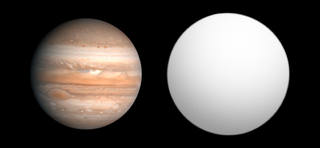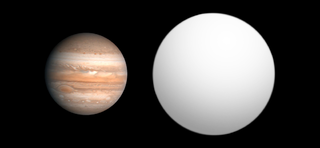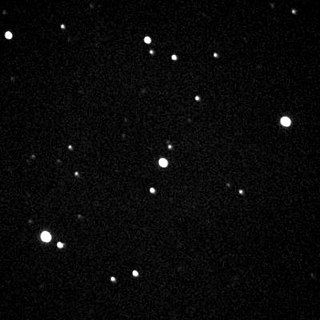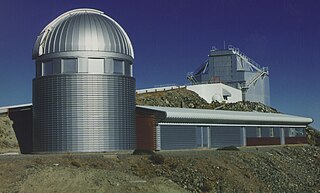
HD 209458 b, which is also nicknamed Osiris after the Egyptian god, is an exoplanet that orbits the solar analog HD 209458 in the constellation Pegasus, some 159 light-years from the Solar System. The radius of the planet's orbit is 0.047 AU, or one-eighth the radius of Mercury's orbit. This small radius results in a year that is 3.5 Earth-days long and an estimated surface temperature of about 1,000 °C. Its mass is 220 times that of Earth and its volume is some 2.5 times greater than that of Jupiter. The high mass and volume of HD 209458 b indicate that it is a gas giant.

TrES-1b is an extrasolar planet approximately 523 light-years away in the constellation of Lyra. The planet's mass and radius indicate that it is a Jovian planet with a similar bulk composition to Jupiter. Unlike Jupiter, but similar to many other planets detected around other stars, TrES-1 is located very close to its star, and belongs to the class of planets known as hot Jupiters. The planet was discovered orbiting around GSC 02652-01324.

Hot Jupiters are a class of gas giant exoplanets that are inferred to be physically similar to Jupiter but that have very short orbital periods. The close proximity to their stars and high surface-atmosphere temperatures resulted in their informal name "hot Jupiters".
OGLE-TR-111 is a yellow dwarf star approximately 5,000 light-years away in the constellation of Carina. Having an apparent magnitude of about 17, this distant and dim star has not yet been cataloged. Because its apparent brightness changes when one of its planets transits, the star has been given the variable star designation V759 Carinae.

OGLE-TR-10b is an extrasolar planet orbiting the star OGLE-TR-10.

WASP or Wide Angle Search for Planets is an international consortium of several academic organisations performing an ultra-wide angle search for exoplanets using transit photometry. The array of robotic telescopes aims to survey the entire sky, simultaneously monitoring many thousands of stars at an apparent visual magnitude from about 7 to 13.

55 Cancri b, occasionally designated 55 Cancri Ab, also named Galileo, is an exoplanet orbiting the Sun-like star 55 Cancri A every 14.65 days. It is the second planet in order of distance from its star, and is an example of a hot Jupiter, or possibly rather "warm Jupiter".

TrES-2b is an extrasolar planet orbiting the star GSC 03549-02811 located 750 light years away from the Solar System. The planet was identified in 2011 as the darkest known exoplanet, reflecting less than 1% of any light that hits it. Reflecting worse than charcoal, on the surface the planet is said to be pitch black. The planet's mass and radius indicate that it is a gas giant with a bulk composition similar to that of Jupiter. Unlike Jupiter, but similar to many planets detected around other stars, TrES-2b is located very close to its star and belongs to the class of planets known as hot Jupiters. This system was within the field of view of the Kepler spacecraft.

Any planet is an extremely faint light source compared to its parent star. For example, a star like the Sun is about a billion times as bright as the reflected light from any of the planets orbiting it. In addition to the intrinsic difficulty of detecting such a faint light source, the light from the parent star causes a glare that washes it out. For those reasons, very few of the exoplanets reported as of April 2014 have been observed directly, with even fewer being resolved from their host star.

WASP-1b is an extrasolar planet orbiting the star WASP-1 located 1,300 light-years away in the constellation Andromeda.

WASP-1 is a metal-rich magnitude 12 star located about 1,300 light-years away in the Andromeda constellation.
WASP-2 is a binary star system in the Delphinus constellation located about 500 light-years away. The primary is magnitude 12 orange dwarf star, orbited by red dwarf star on wide orbit. The star system shows an infrared excess noise of unknown origin.

TrES-4b is an extrasolar planet, and one of the largest exoplanets ever found, after WASP-12b, WASP-17b, CT Chamaeleontis b, GQ Lupi b and HD 100546 b. It was discovered in 2006, and announced in 2007, by the Trans-Atlantic Exoplanet Survey, using the transit method. It is approximately 1,400 light-years (430 pc) away orbiting the star GSC 02620-00648, in the constellation Hercules.
This page describes exoplanet orbital and physical parameters.

WASP-14b is an extrasolar planet discovered in 2008 by SuperWASP using the transit method. Follow-up radial velocity measurements showed that the mass of WASP-14b is almost eight times larger than that of Jupiter. The radius found by the transit observations show that it has a radius 25% larger than Jupiter. This makes WASP-14b one of the densest exoplanets known. Its radius best fits the model of Jonathan Fortney.

OGLE-TR-111b is an extrasolar planet approximately 5,000 light-years away in the constellation of Carina. The planet is currently the only confirmed planet orbiting the star OGLE-TR-111.

Leonhard Euler Telescope, or the Swiss EULER Telescope, is a national, fully automatic 1.2-metre (47 in) reflecting telescope, built and operated by the Geneva Observatory. It is located at an altitude of 2,375 m (7,792 ft) at ESO's La Silla Observatory site in the Chilean Norte Chico region, about 460 kilometers north of Santiago de Chile. The telescope, which saw its first light on 12 April 1998, is named after Swiss mathematician Leonhard Paul Euler.

GSC 03549-02811, also known as Kepler-1) is a yellow main-sequence star similar to the Sun. This star is located approximately 704 light-years away in the constellation of Draco. The apparent magnitude of this star is 11.41, which means it is not visible to the naked eye but can be seen with a medium-sized amateur telescope on a clear dark night. The age of this star is about 5 billion years.
GSC 02620-00648 is a double star in the constellation Hercules. The brighter of the pair is a magnitude 12 star located approximately 1,660 light-years away. This star is about 1.18 times as massive as the Sun.

An exoplanet is a planet located outside the Solar System. The first evidence of an exoplanet was noted as early as 1917, but was not recognized as such until 2016; no planet discovery has yet come from that evidence. What turned out to be the first detection of an exoplanet was published among a list of possible candidates in 1988, though not confirmed until 2003. The first confirmed detection came in 1992, with the discovery of terrestrial-mass planets orbiting the pulsar PSR B1257+12. The first confirmation of an exoplanet orbiting a main-sequence star was made in 1995, when a giant planet was found in a four-day orbit around the nearby star 51 Pegasi. Some exoplanets have been imaged directly by telescopes, but the vast majority have been detected through indirect methods, such as the transit method and the radial-velocity method. As of 1 May 2023, there are 5,366 confirmed exoplanets in 3,962 planetary systems, with 856 systems having more than one planet. This is a list of the most notable discoveries.
















